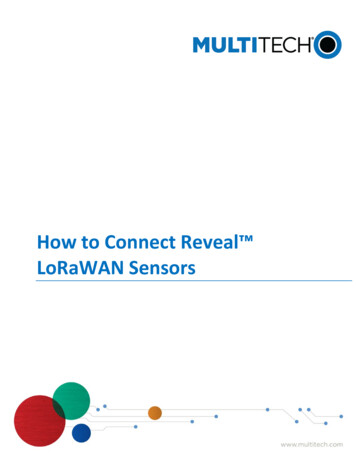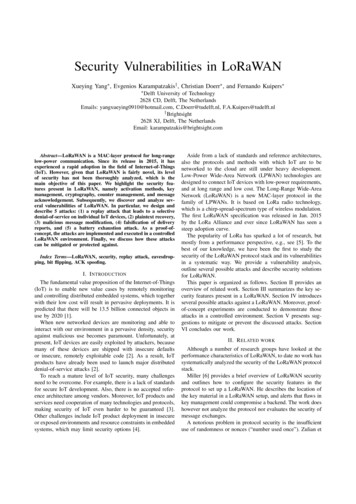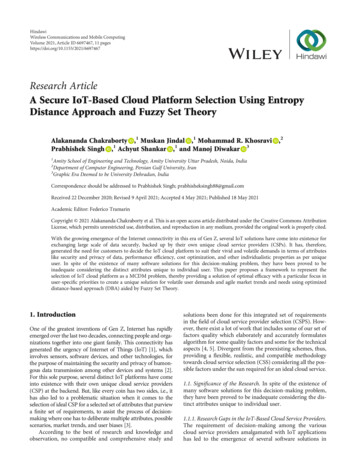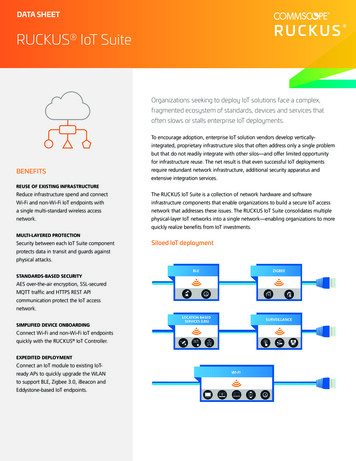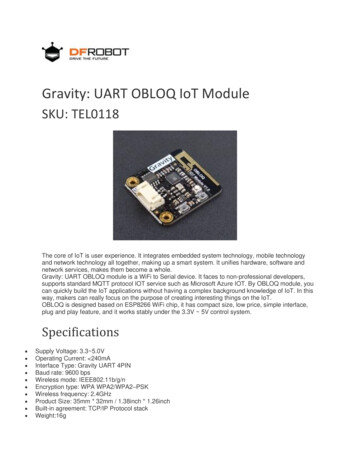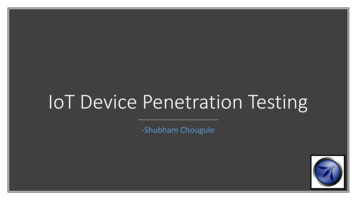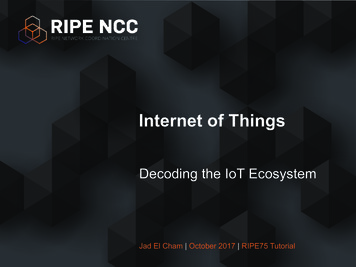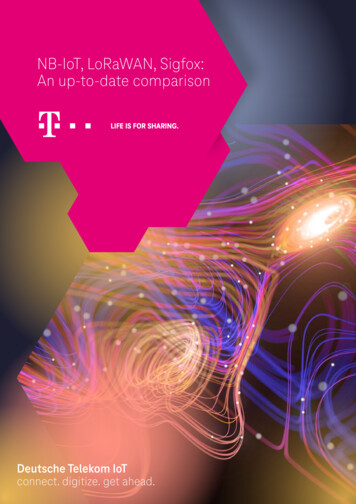
Transcription
Deutsche Telekom IoTconnect. digitize. get ahead.NB-IoT, LoRaWAN, Sigfox:An up-to-date comparisonDeutsche Telekom IoTconnect. digitize. get ahead.
Table ofContentsNB-IoT, LoRaWAN, Sigfox: An up-to-date comparison. 31.Quality of transmission. 52.Coverage.113.Energy efficiency. 134.Security. 155.Costs.176.Future viability. 19In short: Which LPWA technology is the best match for my IoT project?. 21Sources / Contact / Imprint.222
NB-IoT, LoRaWAN, Sigfox:An up-to-date comparison“Low Power Wide Area” (LPWA) is a category of wireless networks– with a very self-explanatory name. Specifically designed for theInternet of Things (IoT), they manage to combine very energyefficient devices with wide transmission ranges. LPWA wirelessmodules can run for years on standard commercial batteries and arenevertheless powerful enough to send readings to the Cloud from,say, basements, underground garages or spread-out shop floors.Examples of LPWA use cases Smart Metering(connected utility meters, sensors in basements) Smart Parking(connected parking lots, sensors in the groundand basement garages) Smart Waste Management(connected municipal trash cans) Asset Tracking(such as countrywide tracking and tracing of cargocarriers like pallet cages, pallets and containers) Connected Buildings(sensors in bridges or tunnels measure temperature,humidity and corrosion and identify vulnerabilitieslong before visible damage occurs) Condition Monitoring(sensors in construction machinery and vehiclesrecognize malfunctions or theft)LPWA technologies are suitable for IoT applications that rely onenergy-efficient and thereby low-cost hardware for massive deployments on a wide range, potentially also within buildings (seebox). Other common wireless technologies cannot serve theseapplication areas or cannot do so satisfactorily: NFC, QR, RFID (low range, low/no energy consumption) WiFi, Bluetooth, ZigBee (low range, high energy consumption) 2G to 5G (high energy consumption, limited indoor penetration)In recent years a number of LPWA network technologies haveestablished themselves in the market. They differ in adoptionand availability, standardization and security, efficiency andeffectiveness. That makes it difficult for companies to find theright technology for their IoT project, as we repeatedly discoverin discussions with our customers. That is why this report takesa closer look at the three most widespread LPWA options: NarrowBand Internet of Things(NarrowBand IoT, NB-IoT, LTE Cat-NB) Long Range Wide Area Network (LoRaWAN) SigfoxWhile LoRaWAN and Sigfox have been on the market for more thanfive years, the first NB-IoT networks were only launched in 2017.Many technology comparisons published to date are thereforebased on theoretical aspects such as specification documents orlaboratory measurements. It is therefore high time for an up-todate comparison from the user's point of view with empiricalvalues from practice in recent years.Wireless IoT put to the testMany differences between NB-IoT, LoRaWAN and Sigfox are dueto their development history. LoRaWAN and Sigfox are proprietarytechnologies developed by individual companies, whereas NB-IoTis an open, global, LTE-based 5G industry standard. As such, it issupported by all the major network suppliers, telcos, and hardwareand chip manufacturers. NB-IoT uses licensed LTE frequency bandsand, unlike LoRaWAN and Sigfox, is always operated by wirelessnetwork providers. With LoRaWAN the user must also choose oneof three deployment options (see box).3
Three LoRaWANoperating modesLocal private network(consists of own gateways and servers,access only by own devices)Can be installed everywhere as required Own control over network capacities and quality All data stays in own networkNetwork operator’spublic network Procurement and installation costs forLoRaWAN gateways and servers(or increased capacities for growingnumber of terminal devices) Running costs for operation,maintenance and support Requires network management knowhow(requires a contract with a provider) No investment in network infrastructurerequired No running costs for operation andmaintenance Subscription fees for network utilization No or no full countrywide network coverage Too many users loss of qualityOpen community network(access to community network,third-party access to own network)Low investment in own gateways Developer ecosystem providing support Running costs for operation and maintenance Limited data volume (with fair use policy suchas with The Things Network) Too many users loss of quality No countrywide network coverageSecurity and data protection risks4
1. Quality ofTransmission5
When assessing the transmission quality of the three main LPWAtechnologies, one should consider reliability, throughput, datarate and range. The observed variances in these four aspects area result of several differences, like in signal modulation, bandwidthper channel, number of channels and spectrum used. First, it isimportant to understand that for LoRaWAN and Sigfox wirelesstransmission in the ISM band is subject to legal restrictions. Theso-called duty cycle is defined as the maximum percentage oftime during which an end device may occupy a channel – that’s asignificant constraint for networks operating in unlicensed bands.The duty cycle is 1 % in the uplink and 10 % in the downlink andleads, for example, to transmission time per participant and hourbeing limited to 360 ms for 1,000 LoRaWAN/Sigfox terminal devicesper gateway.Reliability:With NB-IoT there is no duty cycle for either uploads or downloads.Twelve channels, each with 15 KHz of bandwidth, or 180 kHz intotal, are fully available per resource block (several blocks cantheoretically be used in the LTE frequency bands). LoRaWAN EUhas to make do with eight 125 KHz channels and a 10 % duty cyclefor downloads over all channels and with three 125 KHz channelsand a 1 % duty cycle for uploads. Sigfox uses 192 kHz of bandwidthin which, due to the ultra-narrowband modulation, users each haveonly 100 hertz of bandwidth at their disposal.With NB-IoT messages can also be repeated very often by the network protocol – an advantage in unfavorable conditions such as inthe basement of a building. With LoRaWAN and Sigfox the numberof repeats is limited by law, thereby reducing building penetration(see table). In addition, an NB-IoT network operator has its own LTEspectrum at its disposal on a long-term basis, whereas regulationscould change in future in the unlicensed ISM band. In a worst casescenario new legal restrictions of transmission frequency or poweron open spectrum would necessitate the replacement of alreadyinstalled IoT devices. Furthermore, LoRaWAN and Sigfox signalstrength is limited by EU law to 14 dBm, whereas NB-IoT providesa transmission power of 23 dBm – a further advantage in terms ofbuilding penetration.Facts & FiguresHow likely are connection setupand data transmission to succeed?NB-IoT uses the licensed LTE frequency range of a mobile operator,preventing interference from other devices. LoRaWAN and Sigfoxhave to transmit via free and generally accessible ISM frequencyranges, running the risk of potential interference caused by otherusers. So the quality of transmission falls as soon as too much trafficon the LoRaWAN gateway or Sigfox base station increases thelikelihood of message loss. With NB-IoT, in contrast, the provider canguarantee a predefined quality of service in the wireless network.Technical DataNB-IoTLoRaWANSigfox (EU)Technologyopen standardproprietaryproprietaryLicensed spectrumyesnonoMax data rate (gross)27 kbit/s5,47 kbit/s (SF7)0,1 kbit/sWorst case data rate( 144 dB link budget)5-6 kbit/s0,297 kbit/s (SF12)0,1 kbit/sMax. payload length(data per message) 1.000 B51 B (EU) / 11 B (US)12 BDownlink capacityunlimitedvery lowvery lowLink budget / max. path loss(Uplink)164 dB141-146 dB163 dBLink budget / max. path loss(Downlink)164 dB151-156 dB158 dBSource: Naumann H. & Oelers W.(2020)6
Due to good channel quality in its licensed spectrum and to a optimized collision mechanism, NB-IoT also has very low packet losses( 5 %) even over long distances. LoRaWAN and Sigfox are influenced by interference and data traffic collisions in their unlicensedspectrum, leading to higher packet losses. That in turn leads tomultiple data transmissions and higher energy consumption. An80 % packet loss rate means, for example, that only one transmission out of five gets through.With LoRaWAN data packet loss increases significantly even overshort distances (see chart). According to a survey by the Universityof Singapore a 40 % packet loss must be accepted when usingLoRaWAN in urban environments over a distance of only threekilometers. It is to note that in Singapore a transmission power of20 dBm, or 6 dBm more than in Europe, is permitted. In Europe thispacket loss rate would be reached over much shorter distances.So over larger distances 90 % of data packets would be lost.The repetitions to compensate the increasing packet loss rate overlonger distances not only lead to higher energy consumption, butcan also cause more collisions with other user traffic, resulting in avicious cycle. With Sigfox packet loss only increases rapidly overlonger distances (cf Offenburg and Singapure studies). NB-IoT,however, is steadily reliable over all distances.ConclusionThanks to its reserved channels NB-IoT provides the most effectivedata transmission. LoRaWAN and Sigfox have less capacity at theirdisposal, leading to less reliable transmission.Packet loss per transmission distance (near/medium/far)Packet Loss rce: "Test and Measurement of LPWAN and Cellular IoT Networks in a Unified Testbed.” Sebastian E. J, Sikora A. (2019)7
Throughput:How much data can be sent over aspecified period?NB-IoT has no statutory or commercial limits to data throughput.Limits to the volume of data that can be sent per day (or per year)are set only by the wireless module’s battery service life, unfavorable transmission conditions or the contractually agreed maximumdata volume, as well as operator-side application developmentguidelines to safeguard cellular network quality (e.g. DeutscheTelekom's IoT Solution Guidelines).Upload: With LoRaWAN and, especially, Sigfox the duty cycle imposes strict limits. A Sigfox data packet is limited to a 12 cycle bytepayload. As a consequence, a Sigfox module has to split a longermessage into several small data packets with a negative effect onenergy consumption and duration of transmission. In addition, onlyfour messages with acknowledgement can be sent per day (or sixuplink-only messages per hour, i.e. 144 per day).The three technologies also differ markedly in data volume permessage and number of messages per day. Most notably, forLPWAN technologies in the license-free band the legal duty cyclekicks in. Throughput is limited to prevent network overload.This limitation must be taken into account for use cases such astracking, especially for devices using WiFi sniffing. In principle, NBIoT and LoRaWAN modules permit upload (from device to server)transmission of longer messages. But with LoRaWAN the dutyMax. payload uplink (byte)NB-IoT1000 LoRaWAN USSigfoxSpreading Factor 10With LoRaWAN the signal transmissioncan be spread over a wide frequencyrange. Bandwidth can be used optionally for either a high data rate or a robusttransmission. The spreading factor (SF)and the bandwidth determine the datarate and the likelihood of reception.LoRaWAN networks use between SF7(for optimal conditions) and SF12 (forbad coverage conditions).51LoRaWAN EU2421124212Spreading Factor 7/8cycle can in less favorable circumstances (long distances, Spreading Factor 10) quickly reduce the theoretical best-case (i.e. shortdistances, Spreading Factor 7/8, see box) of 242 Bytes to 51 Bytes(EU) or even 11 Bytes (USA). As NB-IoT is not subject to technical orstatutory limitations, payloads in excess of 1 kilobyte are possible(see chart).Download: NB-IoT also enables downlink reception of larger datapackets. As practice has shown, usual firmware updates (goingbeyond smaller parameter updates) are not a problem for thewireless module or the application on the terminal device. Andfor a very large firmware update of several megabytes commonmultimode wireless modules can switch briefly to 2G or LTE-M fora fast data transmission to save battery life. Realistically, SigfoxSpreading factorSource: Naumann H. & Oelers W.(2020)does not permit firmware updates; if anything, just short controlcommands. In general, message reception is only possible aftertransmission and is limited to 8 bytes each four times a day. WithLoRaWAN, firmware updates, if they are possible at all in view ofthe low data rates, require a high level of energy consumption.So with both proprietary technologies downlink capacity is ingeneral very limited when compared with NB-IoT.ConclusionFor uploads, downloads, data volumes per day or per message orthe number of messages per day, NB-IoT leads the field in everyaspect of data throughput.8
Data rate:How fast can data be sent?In some scenarios fast data transmission is important. As the chartshows, NB-IoT is the clear leader here, and not only in good transmission conditions. With LoRaWAN (EU), interference in the ISM bandreduces the data rate that is theoretically possible under ideal conditions from 5470 bit/s (with SF7) to less than 300 bit/s (with SF12).Especially in difficult conditions only NB-IoT ensures fast and reliabletransmission. Sigfox loses its connection in poor conditions whileLoRaWAN does so even in moderate conditions. This advantagecould come even more to the fore in the future because NB-IoT inprinciple also supports the multi-tone process, which would furthersignificantly increase the current data rate.ConclusionFor data rate NB-IoT has the greatest lead over Sigfox and LoRaWAN– in good and, especially, in worse conditions.Typical data rate (bits per second)27,000Excellent5,470100Coverage TXXLoRaWANSigfoxX No ConnectionSource: Naumann H. & Oelers W.(2020)* Excellent Ideal Conditions ( 130 dB); Good Open Area ( 140 dB); Medium Indoor ( 150 dB); Poor Deep Indoor ( 160 dB)9
Range:How far can messages be transmittedin specified conditions?A study by the University of Aalborg shows that noise and interference are to be expected in the ISM band that LoRaWAN and Sigfoxuse. That can have a negative impact on both the sensitivity (thelink budget with real noise) of the receiver and the range of thetransmitter. In contrast, the NB-IoT network's inherent ability tosend data as often as needed to reach its destination is a decisiveadvantage where range is concerned. The Okumura-Hata simulationmodel also shows that in a typical urban use scenario an NB-IoTor a Sigfox device can transmit much farther than a LoRaWANdevice, on which interference from other users has a significantimpact (see chart). Generally speaking, a link budget increaseof 10 dB will double the transmission range, hence reducing thenumber of required base stations or gateways by a factor of four.A field test by the independent consultancy P3 Communications(today: Umlaut) demonstrated in 2018 that NB-IoT modules atvarious indoor locations were able in 95 % of cases to establish aconnection with the base station. Data transmission then alwaysworked. No other wireless technology can deliver such a highlevel of reliability, especially in basements. LoRaWAN in particularis at a great disadvantage in this context due to strong interferencecaused by other users in, say, a shopping mall or a business park.ConclusionIn the unlicensed ISM band noise and interference reduce the range,in particular in urban environments. While Sigfox compensates thiswith a high output power, the reach of LoRaWAN remains low. NB-IoTcan improve its range and building penetration using the CoverageEnhancement feature on its licensed spectrum.Max. range in city indoor (m)Scenario:2,0001,500CE 21,0005000CE 1CE 0NB-IoT(144-164 dB)Coverage Enhancement (CE) Levels:CE 0 goodLoRaWAN(144 dB)CE 1 mediumSigfox(158 dB)CE 2 poor Large/Medium City(Hata Propagation Model) One Wall between Basestation/Gateway & Device 28 dB Loss (Penetration Loss,Fading) Basestation/Gateway Height: 30m Device Height: 1m Bidirectional transfer withacknowledgement (UL/DL)Source: Naumann H. & Oelers W.(2020)10
2. Coverage11
There are substantial differences in network coverage between thethree technologies, but NB-IoT here enjoys a decisive advantage. Itis based on the 3GPP LTE industry standard, runs on the same basestation equipment and can therefore utilize existing LTE networkinfrastructures. In Germany, for example, around 60,000 LTE basestations – an estimated 20,000 per network provider – can ensurecountrywide availability, especially with national roaming increasingly becoming common. For LoRaWAN and Sigfox setting up andoperating a sufficient number of dedicated base stations (gateways) would not be viable. LoRaWAN provides public communitynetworks in many urban locations but without any guarantee ofquality. Much the same applies to international availability:More than 100 mobile network operators in 54 countries (by the endof 2020) already operate NB-IoT, including all industrialized nations.For NB-IoT as a global 3GPP standard, cross-country, cross-networkand cross-provider roaming is feasible and already live. In 2020 firstcommercial roaming agreements were struck and since then theextention of operator roaming footprints is steadily accelerating. Inaddition, to ensure global availability of wireless connections, manyNB-IoT modules can fall back on 2G/3G or LTE-M wireless networkswhere NarrowBand IoT is not yet available.LoRaWAN networks are said by the LoRa Alliance to exist in over160 countries, mostly as local installations. Roaming is difficult because a reliable contractual framework exists in only a few cases.Decentralized roaming between private, public and open networksposes reliability and security risks. Due to different frequencybands and national regulations (e.g. duty cycles), LoRaWAN modules are also not universally compatible between Europe, NorthAmerica and Asia.Sigfox is said on its website to be in use in around 70 countries.A globally centralized core network infrastructure facilitatesthe utilization of foreign networks, but due to the low number ofbase stations per country there is no reliable international (indoor)network coverage. And as at the end of 2020, there is stillwirelessmodule with worldwide certification.ConclusionAnyone who runs IoT applications countrywide, or indeed acrossborders, will find that only cellular standards such as NB-IoT canoffer the necessary coverage. Proprietary technologies on unlicensed spectrum lack international (indoor) network coverage andespecially LoRaWAN lacks a secure and reliable roaming option.12
3. EnergyEfficiency13
More data packets More energy consumptionIn an IoT scenario such as connecting parking lots, trash cans ortrackers wireless modules must use as little energy as possible.That is the only way in which a module can run for a long time without maintenance of the battery. That not only makes the devicesindependent of a fixed power source such as a socket; it also keepsrunning costs low. Energy efficiency is therefore indispensable formass usage of LPWA, such as in a Smart City.In the past, many studies based their findings mainly on lab resultsusing small data packets. That is why the Lübeck-based engineering company Triptec carried out practical tests in real conditionsmeasuring 12-, 24-, 64- and 512-byte data packets. These were followed by a metrological examination in optimal (outdoor), mixedand difficult reception conditions in a basement (see chart).These practical tests showed that, because many use cases canquickly require a message size of 200 bytes or more, NB-IoT devicesbenefit from being able to send such large data packets in onepiece. Sigfox would in contrast need to split even a 64 byte messageinto six separate packets, requiring six times the energy to transmit.At almost 1,000 mWs each, energy consumption would be extremely high because Sigfox technology does not allow adjustingtransmission power to reception conditions. Hence, frequent status or position reports are not compatible with a long battery life.LoRaWAN is relatively economical in good coverage conditionsand with very small amounts of data, but it fails if conditionsdeteriorate too much (see chart). Longer distances automaticallylead to an increase in packet losses, requiring repetitions whichincrease the energy consumption.Energy consumption for uplink data transmission (mWs)ConclusionOptimal outdoor reception conditions (134 dB Link Budget)If very low energy consumption isimportant for an IoT application, inmost cases there is no alternativeto NB-IoT. There are limits to Sigfoxand LoRaWAN, especially for largerdata packets and poor transmissionconditions.186NB-IoT210132LoRaWAN EU*475980Sigfox5850Using Deutsche Telekom's IoT Solution Optimizer developerscan simulate and optimize the energy consumption of NB-IoTdevices for various use cases and coverage conditions. (Link:https://iot.telekom.com/en)Medium reception conditions (144 dB Link Budget)362NB-IoT431625LoRaWAN EU*2250980Sigfox5850Difficult indoor reception conditions (154 dB Link Budget)5393NB-IoTLoRaWAN EU*5536XX980Sigfox12 bytes (verysmall message)An SMS text message as a transmissionmedium would – in terms of energyefficiency – not be a viable alternativeto LPWA technologies. For its maximum range (144 dB) it requires 3,500mWs, and even in an optimal case(134 dB) it would still use 450 mWs.585064 bytes (moreusual case)X no connection *NB-IoT and Sigfox protocols have radio transmission repetitions built-in. For LoRaWAN theseSource: Naumann H. & Oelers W.(2020)need to be initiated by the application to mitigate packet loss and collisions (increasing withtransmission distance). Hence, to ensure a like-for-like comparison, two repetitions wereassumed for 134 dB and three for 144/154 dB.14
4. Security15
Viewed realistically, security still ranks lower on the list of prioritiesfor developers and users than aspects such as technical reliability,energy efficiency or costs. It also seems obvious to assume thatfor a hacker attacking small, non-critical IoT devices would notbe worthwhile, but that would be a dangerous fallacy. So securityaspects should be taken into account at an early stage of development even if, generally speaking, they will only become a majorfocus of attention as the technology moves closer to maturity.LoRaWAN for IoT: Vulnerabilities in v1.0With LoRaWAN the security depends largely on which versionis used. The new 2017 v1.1 architecture eliminates a number ofvulnerabilities and security gaps in Version 1.0 such as that inend-to-end encryption of frame payloads the network server gainsaccess to the key during the terminal device joining process. As ofthe end of 2020, however, the new Version 1.1 is not yet universallydeployed.Sigfox: Vulnerable to attacksSigfox, despite its integrated security mechanisms, is inherentlymore vulnerable to attacks due to its very small message sizesand its short 12-bit sequence number because simple brute forcemethods can wreak damage. Replay and DoS attacks have beensimulated successfully on several occasions.The most critical vulnerability of LoRaWAN v1.0 and, above all,Sigfox is to be found in their terminal devices. On cost groundsthey do not, as a rule, have a secure element – a chip that storescryptographic information such as secret keys securely. A hackermight therefore succeed in extracting secret keys or in flashingthe device with compromised firmware. Using devices without asecure element can make even end-to-end encryption useless.NB-IoT: Secure key exchangeNB-IoT in contrast benefits from LTE security features that havelong proven their worth in practice. They include mutual authentication of terminal device and network, well-known cryptographicalgorithms such as AES and secure key generation and exchange.On the network side NB-IoT’s air interface is always encrypted. Another major advantage is that NB-IoT SIM cards are tamper-proofbecause they contain a secure element. That makes extracting thekey very difficult and in most cases unlikely to succeed.End-to-end encryption is not standard, but network operators canintroduce a higher level of security by, for example, using a security tunnel between the core network and the application server.For roaming in NB-IoT networks additional security measures suchas end-to-end encryption should be implemented. If, however, anNB-IoT use case takes place solely in the network operator’s homenetwork no additional security mechanisms are required duringtransmission.ConclusionIf the planned IoT application is security-critical, LoRaWAN v1.0and, in particular, Sigfox are not suitable. NB-IoT provides moresecurity, especially because its SIM cards are tamper-proof. However, as the IoT market matures, the security mechanisms of allthree technologies will certainly be continuously scrutinized andimproved.You will find a detailed comparison of the security mechanismsof NB-IoT and LoRaWAN in the Mobile IoT Security Comparisonwhite paper.16
5. Costs17
The cost structure of setting up an IoT wireless network with LPWAtechnology depends to a decisive extent on the operating mode,i.e. whether one subcribes to a network operator or chooses todeploy and operate own network infrastructure (see table). Sigfoxdevices and wireless modules are currently (as of 2020) the leastexpensive, partly because they use by far the simplest technology. LoRaWAN modules have been on the market since 2015 andtherefore had a starting advantage of about two years over NB-IoT.But the prices of NB-IoT hardware are falling rapidly due to highproduction volumes (especially in China) and constantly increasing sales figures with the result that the original price target of 4per wireless module was undershot only a few years after the firstNB-IoT networks were set up.Usage fees vs. investment costsThe cost of SIM cards (or of SIM profiles for integrated SIMs suchas nuSIM) is negligible in relation to the cost of devices. Annualusage fees per device (*) – usually single-digit for NB-IoT, doubledigit for Sigfox and operator-managed LoRaWAN – make a bigdifference, however, especially in long-term projects.Cost factorsfor deploymentSetting up a private LoRaWAN network may eliminate usage feesbut will require investment in network infrastructure such as thepurchase and installation of local gateways and network servers(although the latter can also be bought as a cloud service). Maintenance and operation, gateway site rent and electricity must alsobe financed. Alternatively, all of these costs are included in thevariable usage fees charged by a provider-operated network andare therefore better to plan (per device).ConclusionFor most IoT use cases the total cost of ownership (TCO) is lowerfor NB-IoT than for LoRaWAN and Sigfox. So the longer an IoT application is scheduled to run, the greater the cost benefit of NB-IoT.However, there might be cases where a local private LoRaWANnetwork might be the better choice.LoRaWANNB-IoTOwn localnetworkSubscriptionwith operatorSigfoxDevices incl. radio module SIM cards –––Subscription fees* – Own network infrastructure– ––Network ops & maintenance– ––Application (server) (*) Please check providers’ websites for the latest prices18
6. FutureViability19
Apart from considerations around technical quality or cost, aselaborated in the previous chapters, any company developing orusing IoT applications and devices should think about the sustainability and future viability of their chosen technology. In particular,the following general questions should be asked: Is it assured that my deployed IoT devices will still work fortheir entire lifetime? Will my provider still exist and operatethe network? Could there be any future regulatory restrictionsforcing me to replace my devices? For future production batches and device generations, will theprices for hardware and subscriptions decline or grow? Willthere be enough players in the market to ensure tough competition for best quality and prices or will I become dependent onone single vendor? Will there be enough resources for and investment on thecontinuous enhancement of the technology? Will there beregular updates to further improve quality and performanceand fix any new security threats? Is there an active developer community to support me in appli cation development and troubleshooting?that the vendor landscape for LoRaWAN semiconductors, devicesor gateways features rather smaller players compared to typicalsuppliers for cellular 3GPP industry standards such as NB-IoTor LTE(-M). The LoRaWAN developer community is decentralizedand diverse, with most notable co
time during which an end device may occupy a channel - that's a significant constraint for networks operating in unlicensed bands. The duty cycle is 1 % in the uplink and 10 % in the downlink and leads, for example, to transmission time per participant and hour being limited to 360 ms for 1,000 LoRaWAN/Sigfox terminal devices per gateway.
